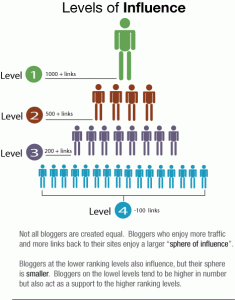
Zillions of pre-teens are under his influence (courtesy of The Global Daily)
Are you under the influence?
If you’re like the billions on Facebook, Twitter, YouTube, or other social networks, you most definitely are. While we can also be influenced by mainstream channels like newspapers, television, radio and magazines, chances are that it is the people we know – our family and friends – who exert the most influence on our behaviours and actions.
I suppose this is why influencer marketing is fast rising in prominence.
According to Wikipedia, influencer marketing is defined as a “variety of recent practices and studies, in which focus is placed on specific key individuals (or types of individual) rather than the target market as a whole. It identifies the individuals that have influence over potential buyers, and orients marketing activities around these influencers.”
So who are these so-called influencers? Well, there are several groups of them:
1) Editors and Journalists These guardians of mainstream media (newspapers, TV, radio, magazine and news portals) exert tremendous influence by virtue of their reach. While the influence of traditional media channels have eroded due to the rise of citizen media, their ability to impact a population is still significant.
2) Bloggers There are bloggers and there ARE bloggers. Just like mainstream media, there is a hierarchy of influencers in the blogging community (see figure below). Some are A-listers with hundreds of thousands of followers, friends or readers. Others are more modest efforts created by “prosumers” who have an ardent interest in food, fashion, travel, photography, events or business.

Courtesy of Logic + Emotion
3) Celebrities and Politicians These larger than life personalities often have huge fan followings. Just look at Lady Gaga and her millions of “Little Monsters”! Politicians, especially presidents, prime ministers and cabinet ministers have significant clout too. Ditto for sports men and women.
4) Friends and Family Naturally, these are the influencers who are closest to you. They are probably easier to convince than a complete stranger, least of all a Hollywood star or the editor of CNN.
To measure online influence, one can use traditional indicators like the number of friends, followers, readers or unique visitors. Other more sophisticated measures include Klout, PeerIndex, Kred, Sprout social and other scoring algorithms which look at how “spreadable” and “engaging” an influencer is vis-a-vis his fans/followers and activity levels. You can read more about measuring influence in this link here.
Once you’ve identified your influencers, you should look at how you can work with them to spread a marketing message for you. Here, there are several factors to consider:
1) Nature of Content Certain types of content are more “viral” than others. To excite your influencers, consider what would tickle their fancy. What are the topics which are likely to catch their fancy, based on the content that they regularly create (or curate)? How likely are they to share your content based on their interests as well as that of their fans/followers? What are the chances of this content generating buzz?
2) Influencer Incentive With so many competing causes going on, one needs to have a strong value proposition to excite one’s influencers. Generally speaking, the higher they are in the hierarchy, the harder it is to convince them. While money (and a plane ticket) can be good motivators, there are influencers who wouldn’t budge unless the initiative is something which they’re keen in. For instance, it is silly trying to get a food blogger to cover a fashion conference (unless of course he/she is a fashionable foodie).
3) Timing and Context Like in all things, opportunity often strikes once (or at most twice). Before you unleash your global domination plan, consider if the hygiene, environmental, and socio-cultural factors are just right.
4) Community Interest Work with your influencers to identify what’s spreadable in their communities, and how you can tailor your content to engage these members. Will it be useful to organise an event to demonstrate the capabilities of your new product? Maybe you could get your celebrity chef to show how your amazing kitchen gadget can work (while getting food bloggers to cover it).
After you’ve developed your content/message, invited your influencers to participate and organised activities to engage their communities, you will need to have a call for action. The best influencer marketing efforts often come with very specific (and attractive) requests for involvement. This can be anything from signing up for an online membership, participating in a contest, to actually purchasing a product or service.
The final thing you need to do is to measure and modify your influence marketing campaign based on the outcomes achieved. Where possible, try to obtain early feedback from your influencer as well as his/her networks. It is good to practice the principles of The Lean Startup here, ie pilot with a smaller marketing initiative, measure and learn from its outcomes.
Naturally, this isn’t all there is to read about Influencer Marketing. However, I hope it provides a good introduction to this topic. 🙂

I was delighted to find this web site. I wanted to thank you for your time reading this wonderful! I really enjoyed every bit of it and I’ve marked to ensure that the blog post something new.
Advertising Companies in Islamabad
I see. So there are so many type of influencer in the world. So do you think influence marketing can change the marketing way?
Thanks for sharing such great information with us. I hope you will share some more info about Micro-influencer. Please keep sharing.
I recommend using collaboration tools such as the one with phlanx in finding influencers, it becomes your search platform with alot of means to narrow down to specific influencers who have the best impact to your market and the highest chance to collab.
Influencer marketing campaign
I’d love to see more examples of successful influencer marketing campaigns, especially ones that are creative and outside the box. It’s always inspiring to learn from real-life success stories in the industry.